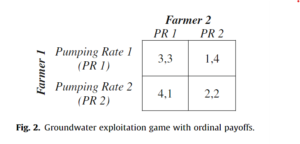In class we learned about game theory, which is ultimately used to study the behavior of rational individuals’ interactions in a given environment.
As in the name, the individuals and their interactions are depicted as a game model. The individuals are the players of the game. Each individual has a set of actions or strategies they can pick. The combined results of everyone’s action leads to different payoffs for individuals. As such, each player will pick a strategy that will maximize the payoff they will receive.
There are many applications of game theory in real life. One such example is to find a resolution (both good and bad) towards water source conflicts. In the article “Game Theory and Water Resources” written by Kaveh Madani, Madani gives some examples of how important game theory can be towards solving current issues faced by people around the world competing for the same source of water.
An example given by the article was a situation very similar to the Prisoner’s Dilemma. In this scenario, there are two farmers sharing an aquifer (layer of water bearing rock) to water their crops. They both plan to be tapping into the aquifer for a long time so they must ensure that it will not dry off.
The revenue (or payoff) for each farmer is the profit gained from crop sales subtracted by the costs of maintaining their pump. The farmers must choose how quickly they want to be pumping. Pumping at a slower rate result in less water being used. As a consequence, less crops can be grown but a lower cost is needed towards pumping. Pumping at a higher rate result in high water usage. However, more profit is gained from selling more crops, although a higher pumping cost is needed.
If both farmers are pumping at a slower rate, both parties will obtain a respectable profit, while ensuring that the aquifer will continue existing for years to come. If both farmers pump at a faster rate, water levels will be low and there is a chance it may be depleted. As such overall profit will be lower as fewer overall crops will be grown over the years and higher costs is needed for maintaining the fast pump. However, if one farmer pumps at a faster rate while the other at a slower rate, then the faster pumping farmer can benefit off of the slower pumping farmer. As long as the combined pumping rates do not exceed a certain amount, water levels will not be a concern. The slower pumping farmer will have to compete with the better crops offered by the faster pumping farmer and hence profits will fall.
From this situation, the following payoff matrix can be obtained where Pumping Rate 1 is the slower pumping rate and Pumping Rate 2 the faster.

As you can see, choosing a faster pumping rate is the dominant strategy for both farmers since the payoff will always be greater compared to pumping slower.
Sadly, even though the most ideal solution would be for both farmers to pump slower, making the rational financial decision costed them both in the end and both had to settle for lesser payoffs. Eventually in the future, water levels will fall to a critical level and their profits will suffer even more.
This scenario would have been beneficial if the parties involved were to cooperate and trusted one another. The article talks about how unfortunately the example situation happens all too often in the real world. Companies sharing the same water resource make the best decisions for themselves without collaborating with one another on optimizing the payoffs so everyone can benefit. But instead, a situation occurs in which less profit is met and consequences for residents actually needing the water happens.
Game theory shows how important it is for every party using the same water source to collaborate together in sharing it. This way, everyone can go home happy at the end of the day.
References:
https://www.sciencedirect.com/science/article/abs/pii/S0022169409007653